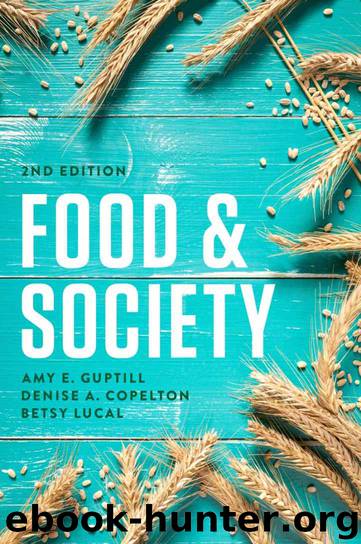Food and Society: Principles and Paradoxes by Amy E. Guptill & Denise A. Copelton & Betsy Lucal

Author:Amy E. Guptill & Denise A. Copelton & Betsy Lucal [Guptill, Amy E.]
Language: eng
Format: azw3
ISBN: 9781509501861
Publisher: Wiley
Published: 2016-12-27T05:00:00+00:00
Environmental costs
While the social impacts of the industrial food system may seem subtle, the environmental impacts are anything but. Certainly, all human activity has an impact on the rest of nature, and premodern societies were more than capable of ruining their environment through overgrazing, over-tilling, and unsustainable irrigation. However, critics see a modern pattern in which the environmental problems created by industrial agriculture are addressed with industrial solutions that then bring new, larger-scale risks. Lyson (2004: 19–20) summarizes the industrialization of the food system in terms of three “technological revolutions”: the “mechanical revolution,” beginning about 1900, the “chemical revolution,” beginning at the end of World War II in 1945, and the “biotechnology revolution,” beginning in the 1980s. In unequal societies, the benefits and burdens of these risks are unequally distributed as well.
A chemical revolution in agriculture began in World War I and continued in World War II. During World War I, German chemist Fritz Haber learned how to synthesize the nitrogen needed for bomb making. Before that, bombs needed natural sources of concentrated nitrogen, such as that found in bat guano. Farmers also needed soil nitrogen, but, because these mined sources were scarce and expensive, they relied on nitrogen-fixing microbes living on the roots of leguminous plants like beans and peas. Planting legumes (such as soybeans) one year would build up soil nitrogen for a non-legume (such as corn) the next. The invention of synthetic nitrogen enabled farmers to skip these rotations and focus on the most high-value crops. Other wartime chemicals, including nerve gases and plantkilling defoliants, became the insecticides and herbicides that chemical companies and agricultural extension agents encouraged farmers to use after the wars were over. As early as the 1970s, there were more than 100 factories in the United States producing more than 1,000 different pesticides (Lyson 2004: 20). Meanwhile, the use of synthetic nitrogen fertilizers increased sevenfold between 1945 and 1980 (Lyson 2004: 20).
These chemicals indisputably boost agricultural production per unit of land, but they also carry risks. A first wave of concern about agricultural pesticides followed the publication of Rachel Carson’s landmark book Silent Spring in 1962. Through a painstaking review of complex scientific findings, Carson, an aquatic biologist, explained how persistent pesticides like DDT were building up in animal tissues throughout the food chain. For example, insects covered in DDT were consumed by other insects, which were then eaten by frogs hunted by birds and other predators. DDT accumulated in the tissues of these longer-living predators. As birds became poisoned, they laid eggs with shells too thin to protect developing embryos. The “silent spring” of Carson’s title described a future without songbirds, made extinct by this inability to reproduce. Carson’s book was an immediate best-seller, galvanizing an environmental movement that has pressed for stronger environmental protections and, as we explain in chapter 9, launching a growing movement to generate alternative systems of food production and distribution. DDT was banned in 1972, and some other persistent pesticides have similarly been taken out of use; but environmentalists and consumers are still concerned about ones that remain.
Download
This site does not store any files on its server. We only index and link to content provided by other sites. Please contact the content providers to delete copyright contents if any and email us, we'll remove relevant links or contents immediately.
Craft Beer for the Homebrewer by Michael Agnew(18087)
Marijuana Grower's Handbook by Ed Rosenthal(3591)
Barkskins by Annie Proulx(3256)
Project Animal Farm: An Accidental Journey into the Secret World of Farming and the Truth About Our Food by Sonia Faruqi(3145)
Red Famine: Stalin's War on Ukraine by Anne Applebaum(2849)
The Plant Messiah by Carlos Magdalena(2842)
0041152001443424520 .pdf by Unknown(2733)
Organic Mushroom Farming and Mycoremediation by Tradd Cotter(2603)
In the Woods by Tana French(2502)
Beer is proof God loves us by Charles W. Bamforth(2348)
7-14 Days by Noah Waters(2298)
Reservoir 13 by Jon McGregor(2219)
The Art of Making Gelato by Morgan Morano(2194)
Meathooked by Marta Zaraska(2179)
Birds, Beasts and Relatives by Gerald Durrell(2157)
Borders by unknow(2151)
Between Two Fires by Christopher Buehlman(2114)
The 7 Habits of Highly Effective People: Powerful Lessons in Personal Change (25th Anniversary Edition) by Covey Stephen R(2108)
The Lean Farm Guide to Growing Vegetables: More In-Depth Lean Techniques for Efficient Organic Production by Ben Hartman(2046)
